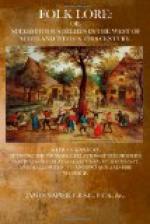There was another phase of supernatural power, different from witchcraft, and which the devil granted to certain parties: this was called the Black Airt. The possession of this power was mostly confined to Highlanders, and probably at this present day there are still those who believe in it. The effects produced by this power did not, however, differ much from those produced by witchcraft. A farmer in the north-west of Glasgow engaged a Highland lad as herd, and my informant also served with this farmer at the time. It was observed by the family that, after the lad came to them, everything went well with the farmer. During the winter, however, the kye became yell, and the family were consequently short of milk. The cows of a neighbouring farmer were at the same time giving plenty of milk. Under these circumstances, the Highland lad proposed to his mistress that he would bring milk from their neighbour’s cows, which she understood to be by aid of the black airt, through the process known as milking the tether. The tether is the rope halter, and by going through the form of milking this, repeating certain incantations, the magic transference was supposed capable of being effected. This proposal to exercise the black airt becoming known among the servants, they were greatly alarmed, and showed their terror by all at once becoming very kind to the lad, and very watchful of what he did. He was known to have in his possession a pack of cards; and during family worship he displayed great restlessness, generally falling asleep before these services were concluded, and he was averse to reading the Bible. One night, for a few pence, he offered to tell the names of the sweethearts of the two servant-men, and they having agreed to the bargain, he shuffled the cards and said certain words which they did not understand, and then named two girls the lads were then courting. They refused to give him the promised reward, and he told them they would be glad to pay him before they slept. When the two men were going to their bed, which was over the stable, they were surprised to find two women draped in black closing up the stable door. As they stepped back, the women disappeared; but every time they tried to get in, the door was blocked up as before. The men then remembered what the lad had said to them, and going to where he slept, found him in bed, and gave him the promised reward. He then told them to go back, and they would not be further disturbed. Next morning, the servant-men told what had taken place, and refused to remain at the farm any longer with the lad; and the farmer had thus to part with him, but he and the servants gave him little gifts that they might part good friends. My informant believed himself above superstition, yet he related this as evidence of the truth of the black airt.
It is a very old belief that those who had made compacts with the devil could afflict those they disliked with certain diseases, and even cause their death, by making images in clay or wax of the persons they wished to injure, and then, by baptizing these images with mock ceremony, the persons represented were brought under their influence, so that whatever was then done to the image was felt by the living original. This superstition is referred to by Allan Ramsay in his Gentle Shepherd:—




